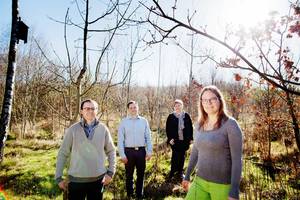Researchers search for valuable resources in the forest
Researchers from Lund University have been awarded a multi-million SEK grant to increase the value of our forests by finding new, more valuable areas of application for the substance lignin.
– Published 8 July 2015

We are facing major challenges within both forestry and the chemicals industry. The value of the raw materials from forestry continues to drop within parts of the traditional paper industry as a result of an increasingly digitalised society, while the demand for environmentally friendly chemicals and sustainably developed products is rising. We must therefore find new areas of application and develop new processes for forestry raw materials in order to increase the value of our forests.
This is what researchers from the Faculty of Engineering and the Faculty of Science at Lund University hope to achieve in a new research project which has received a multi-million SEK grant from the Foundation for Strategic Research. Its aim is to develop processes for new valuable applications of the forestry product, lignin.
Lignin is present in biomass from both forestry and agricultural waste. It is a complex and not easily degradable raw material with fewer areas of application than the other primary raw materials from forestry, namely cellulose and hemicellulose. Lignin is mostly considered as a by-product which can be used as fuel in the process or, for example, in cement and concrete as a liquefying agent.
“Lignin is a complex material which is based on a number of known chemical building blocks combined in partly random processes into a large polymer. It is a major challenge to understand and break down the structure into usable components. The structure is a little like a black box”, explains research director Marie Gorwa-Grauslund.
Lignin is important both to protect the tree and to hold the structure together – a bit like glue.
Around 15–30% of the waste products from forestry and agriculture consist of lignin. Major profits would therefore ensue if lignin could be used as a raw material for more valuable products than fuel. The challenge is to break down and convert the lignin into the desired fine chemicals, however.
The project mainly consists of two parts. Researcher Christian Hulteberg, who works on the development of catalytic methods for the decomposition of lignin, and Charlotta Turner, who is responsible for the analytical work, constitute one part of the project. The other part is led by Marie Gorwa-Grauslund and Gunnar Lidén, who are focusing on converting lignin components into various bulk chemicals, using new microorganisms and processes.
“The aim of the project is to create a platform for research and use of the forestry product lignin, with a view to extracting more valuable products from forestry, thereby increasing its value”, says Marie Gorwa-Grauslund.
The project is categorised as high-risk but the researchers are convinced that, over its five-year span, it will reveal new areas of application for our forestry industry and hopefully develop new environmentally friendly and valuable chemicals from the raw material lignin.
Facts
The research project has been awarded SEK 26 million from the Foundation for Strategic Research (SSF) between 2015 and 2019.
The project is made up of the research directors, Marie Gorwa-Grauslund, Christian Hulteberg, Gunnar Lidén and Charlotta Turner from the Faculty of Engineering and the Faculty of Science at Lund University.
During the spring, around five doctoral students and post-docs will be recruited to the project.
The vision is to increase the value of forestry by finding new valuable areas of application for the currently very underexploited forestry raw material, lignin.
Read more about the project on http://www.lignin.lu.se/
Three potential future areas of application for lignin:
- Bioplastics
- Starting material for new drugs
- Aviation fuel
